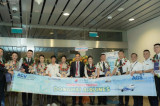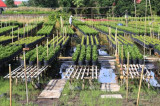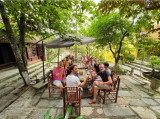Rivers provide major resources to boost Vietnam’s tourism
Running across the country, rivers not only facilitate the transportation of passengers and goods but also provide a major resource for developing river tourism by enabling amazing experiences for visitors.
By leisurely taking a boat along the Red River in the mist gently covering the riverbed, tourists can admire the charming scenery of Hanoi and the beauty of ancient bridges such as Long Bien Bridge and Chuong Duong Bridge. During their journey, they can stop in Bat Trang pottery village, Ninh So bamboo and rattan weaving village, and other historical and cultural sites such as Chem communal house and Saint Giong Temple.
In Ho Chi Minh City, a boat tour along the Saigon River will allow passengers to explore Thu Thiem Tunnel, Nha Rong Wharf, and Phu My Bridge.
Coming to the Mekong Delta, visitors can join boat tours to fruit orchards, where they can learn about the lives of residents on floating markets while enjoying traditional music performances.
The attraction of rivers has become a potential resource to diversify Vietnam’s tourist products.
Possessing a dense river network with more than 2,300 large and small rivers stretching from north to south, including many rivers flowing through or between provinces, regions, and countries, such as the Red River, the Mekong River, and the Da River, Vietnam has a great advantage to develop river tourism routes.
River tourism not only helps diversify products, enhance the competitiveness of Vietnamese tourism, and promote the culture of indigenous people but also contributes to addressing the overloading of road tourism.
In recent years, many localities have paid due attention to developing river tourism and have achieved encouraging results.
Among them, Ha Giang Province is a typical example. The launch of scenic boat rides along the Nho Que River at the foot of Ma Pi Leng Pass, one of the most stunning rivers in Vietnam, has drawn much interest from visitors.
According to Lai Quoc Tinh, Chairman of the Ha Giang Provincial Tourism Association, this is an unexpected success for the province's tourism industry. In 2023, more than 50 boats operating on the river brought in 33 billion VND for the tourism industry.
In Thua Thien Hue Province, up to 40% to 45% of the total number of visitors each year opt to travel on the Huong River to experience the beauty of Hue imperial city.
Similarly, each year, up to two-thirds of total holidaymakers to Can Tho City join river tours to the Cai Rang floating market, fruit gardens in Phong Dien District, and historical and cultural sites in Binh Thuy District, during which they can also enjoy local dishes and art performances.
In Ho Chi Minh City, a series of river tourism products, such as sunset cruise tours on the Saigon River, tours to Thu Duc green city, and Saigon River buses, have been put into operation, attracting the great attention of visitors.
Despite the positive signals, river tourism has not yet fully tapped its potential. Most of the tourist products are sightseeing tours without integrating the introduction of the local culture of residents living along the banks of the rivers. Thus, they failed to encourage tourists to stay longer and spend more.
According to Dr Nguyen Anh Tuan, Director of the Institute for Tourism Development Research, the biggest obstacle hindering river tourism is the limited waterway transport infrastructure.
The number of ports which can accommodate cruise ships in Vietnam is still modest, mainly concentrated in big cities such as Hanoi, Da Nang, and Ho Chi Minh City.
It is not to mention the alarming environmental pollution in many large rivers.
Given the situation, experts stressed that it is necessary to develop a strategy and plan for river tourism development with the full participation of state management agencies in the tourism, culture, and transportation sectors, along with experienced businesses and experts.
Dr Tran Diem Hang from the Faculty of Tourism under Hoa Binh University emphasised the need to make bolder investments in improving infrastructure by upgrading and constructing new wharves with proper facilities such as waiting rooms, toilets, parking lots, information centres, restaurants, cafes, and shopping areas.
She suggested integrating river tourism products with other forms of tourism, such as culture tourism, by visiting historical sites, traditional craft villages, churches, and pagodas along the river.
This also includes eco-tourism by exploring nature reserves, mangrove forests and wildlife, culinary tourism by learning about local specialties and culinary craft villages, as well as resort tourism by staying in high-class riverside resorts and golf courses and adventure tourism by providing kayaking, diving, and surfing.
In addition, river tours can also be part of festivals to enhance visitor experience.
Dr Nguyen Anh Tuan affirmed that each river has its own historical stories, cultural values and ecosystems. Developing specific tourism products with reference to these values will attract tourists’ interest.
He called for closer coordination between localities in designing inter-regional tours linking numerous locations on the same river route to create a flow of experiences for tourists.
Meanwhile, lecturer Vu Nam from the Faculty of Tourism and Hospitality at the National Economics University noted that the operation of river tourism must include strict safety measures.
Accordingly, means of transport must meet technical requirements to transport passengers, service staff must be equipped with professional skills and knowledge on fire prevention and rescue, and have certificates from training agencies.
He added that attention must also be paid to maintaining sustainable development and environmental protection while encouraging local communities’ participation in promoting the destinations' unique cultural and historical values to visitors.
NDO
 Mekong Delta tourism continues to surge
Mekong Delta tourism continues to surge
 Phu Quoc expects to welcome 1 million foreign travellers in 2025
Phu Quoc expects to welcome 1 million foreign travellers in 2025
 Five most popular cities in Vietnam for New Year Holiday 2025
Five most popular cities in Vietnam for New Year Holiday 2025
 Vietnam among top 3 destinations appealing to Australians
Vietnam among top 3 destinations appealing to Australians
 Tourism to accelerate sustainable growth in rural areas
Tourism to accelerate sustainable growth in rural areas
 Hanoi, HCM City among world’s top 100 city destinations in 2024
Hanoi, HCM City among world’s top 100 city destinations in 2024
 Thailand plans “grand” travel year 2025
Thailand plans “grand” travel year 2025
Central tourism hub works hard to attract more holiday-makers
 Provincial tourism promotion center strengthens application of digital technology in tourism promotion
Provincial tourism promotion center strengthens application of digital technology in tourism promotion
 Community tourism transforms livelihoods in remote areas
Community tourism transforms livelihoods in remote areas




